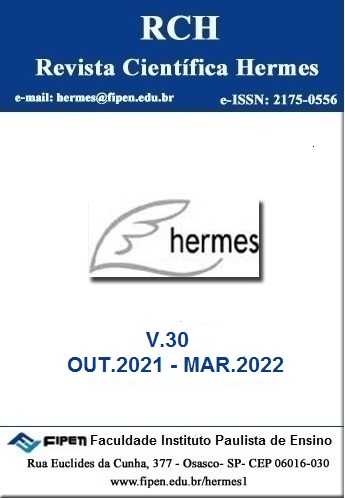Circular economy: case study at the ABC company
DOI:
https://doi.org/10.21710/rch.v30i0.613Keywords:
circular economy, sustainability, electronic wasteAbstract
The circular economy (EC) is seen as a key process to promote the dissociation between high resource consumption and economic growth. It has numerous benefits, but there are still gaps between its theory and the implementation process. This article aims to analyze and highlight the advantages and benefits of applying the circular economy, as well as identifying important points to face barriers and reach opportunities in the manufacturing sector. The research strategy adopted was exploratory research carried out through interviews, with people from the company involved in the subject in question. The result showed that the development of partnerships is fundamental in the circular economy. In the researched company, the partnerships, to optimize the reverse logistics, allowed to reduce the customer costs by up to 30% and increase the collection time by 50%.
References
Campolina, J., Sigrist, C., De Paiva, J., Nunes, A.,& Moris, V. (2017). A study on the environmental aspects of WEEE plastic recycling in a Brazilian company. The International Journal of Life Cycle Assessment volume -Springer, 1957-1968.
COM -European Commission(2014). Towards a circular economy: a zero waste programme for Europe. Bruxelas.
Di Maio F., Rem C. P. A Robust Indicator for Promoting Circular Economy through Recycling. Journal of Environmental Protection,Vol.6 No.10, October 9, 2015.
Flex. Bringing circular manufacturing to electronics with Sinctronics.Recuperado de https://flex.com/resources/bringing-circular-manufacturing-to-electronics-with-sinctronics
Garcés, C., Rivera, P., Suárez, I.,& Dante I. La Hiz, L.(2019).Is it possible to change from a linear to a circular economy? An overview of opportunities and barriers for European small and medium-sized enterprise companies. International Journal of Environmental Research, 1-15. doi:10.3390/ijerph16050851
Geissdoerfer, M., Savaget, P., Bocken, N. M. P.,& Hultink, E.J. (2017). The circular economy: A new sustainability paradigma?Journal of Cleaner Production,143,757-768.
Gonçalves, M. T.,& Barroso, F. A.F. (2019). A engenharia de produção como meio de transformação social. XI SIMPROD Juiz de Fora, BH.
Govindan, K.,& Hasanagic, M. (2017). A systematic review on drivers, barriers, and practices towards circular economy: a supply chain perspective. International Journal of Production Research, 278-311. doi: 10.1080/00207543.2017.1402141
Gower, R.,& Schroeder, P. (2016). Virtuous circle: How the circular economy can save lives and create jobs in low and middle income contries. Tearfund and Institute of Development Studies.
Gregson, N., Crang, M., Fuller, S.,& Holmes, H. (2015). Interrogating the circular economy: the moral economy of resource recovery in the EU. 25. doi: 10.1080/03085147.2015.1013353
Hasanagic, M.,& Govindan, K. (2017). A systematic review on drivers, barriers, and practices towards circulareconomy: a supply chain perspective. International Journal of Production Research, 278-311. doi: 10.1080/00207543.2017.1402141
Kirchherr, J., Kris Hartley, Roosendaal, J. (2021). Barriers to the circular economy: The case of the Dutch technical and interior textiles industries. Journal of Industrial Ecology,1–14. doi/10.1111/jiec.13196
Kumar, V., Sezersan, I., Garza-Reyes, J. A., Gonzalez, E.,& Al-Shboul, M. A. (2019). Circular economy in the manufacturing sector: benefits, opportunities and barriers. Emerald Insight, 19. doi:10.1108/MD-09-2018-1070
Lakatos, E. M.,& Marconi, M. (2003). Fundamentos de metodologia científica. São Paulo: Atlas.
MacArthur. E. Foundation. (2014). Towards the Circular Economy, v.3. Cowes: Ellen MacArthur Foundation.
Preston L. Benjamin.(2002). Spatial Patterns in Benthic Biodiversity of Chesapeak Bay. USA: Association With Water Quality and Sediment Toxicit.
Sariatli, F. (2017). Linear economy versus circular economy: Comparative and analyzer study for optimization of economy for sustainability. Visegrad Journal on Bioeconomy and Sustainable Development, 1-34. doi:10.1515/vjbsd-2017-0005
Sauvé, S., Bernard, S.,& Sloan, P. (2016). Environmental sciences, sustainable development and circular economy: Alternative concepts for trans-disciplinary research. Environmental Development, 48-56.
Schroeder, P., Anggraeni, K.,& Weber, U. (2018). The relevance of circular economy practices to the sustainable development goals. Journal of Industrial Ecology, 1-19. doi:10.1111/jiec.12732
Tiossi, F. M., & Simon, A. T. (2017). A economia circular como ferramenta de apoio ao desenvolvimento sustentável.Anais do Fórum de Iniciação Científica do Unifunec,7(7). Recuperadodehttps://seer.unifunec.edu.br/ index.php/ forum/article/ view/2590
Van Buren, N., Demmers, M., Van Der Heijden, R., & Witlox, F. (2016). Towards a circular economy: The role of dutch logistics industries and governments. Sustainability, 17. doi:10.3390/su8070647
Winans, K., Kendall, A.,& Deng, H. (2017). The history and current applications of the circular economy concept. Elsevier, 825-833. doi:10.1016/j.rser.2016.09.123
Downloads
Published
How to Cite
Issue
Section
License
Copyright (c) 2021 Revista Científica Hermes - FIPEN

This work is licensed under a Creative Commons Attribution 4.0 International License.






